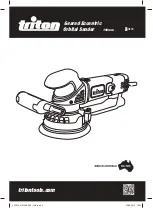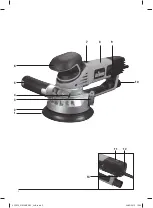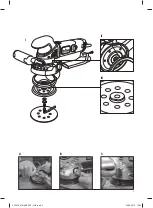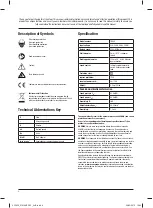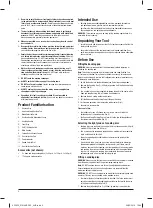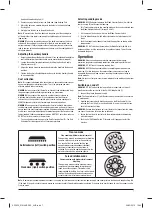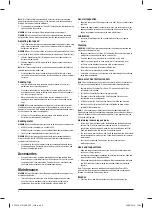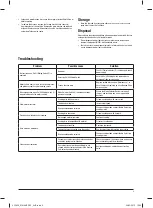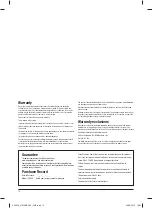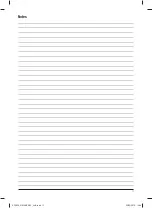
5
General Safety
WARNING Read all safety warnings and all instructions.
Failure to follow
the warnings and instructions may result in electric shock, fire and/or serious
injury.
WARNING: This appliance is not intended for use by persons (including
children) with reduced, physical or mental capabilities or lack of
experience or knowledge unless they have been given supervision or
instruction concerning use of the appliance by a person responsible for
their safety.
Children must be supervised to ensure that they do not play with
the appliance.
Save all warnings and instructions for future reference.
The term “power tool” in the warnings refers to your mains-operated (corded)
power tool or battery-operated (cordless) power tool.
1) Work area safety
a)
Keep work area clean and well lit.
Cluttered or dark areas invite
accidents
b)
Do not operate power tools in explosive atmospheres, such as in the
presence of flammable liquids, gases or dust.
Power tools create
sparks which may ignite the dust or fumes.
c)
Keep children and bystanders away while operating a power tool.
Distractions can cause you to lose control.
2) Electrical safety
a)
Power tool plugs must match the outlet. Never modify the plug in
any way. Do not use any adapter plugs with earthed (grounded)
power tools.
Unmodified plugs and matching outlets will reduce risk of
electric shock.
b)
Avoid body contact with earthed or grounded surfaces, such as
pipes, radiators, ranges and refrigerators.
There is an increased risk of
electric shock if your body is earthed or grounded.
c)
Do not expose power tools to rain or wet conditions.
Water entering a
power tool will increase the risk of electric shock.
d)
Do not abuse the cord. Never use the cord for carrying, pulling or
unplugging the power tool. Keep cord away from heat, oil, sharp
edges or moving parts.
Damaged or entangled cords increase the risk of
electric shock.
e)
When operating a power tool outdoors, use an extension cord
suitable for outdoor use.
Use of a cord suitable for outdoor use reduces
the risk of electric shock.
f)
If operating a power tool in a damp location is unavoidable, use a
residual current device (RCD) protected supply.
Use of an RCD reduces
the risk of electric shock.
3) Personal safety
a)
Stay alert, watch what you are doing and use common sense when
operating a power tool. Do not use a power tool while you are tired
or under the influence of drugs, alcohol or medication.
A moment of
inattention while operating power tools may result in serious personal
injury.
b)
Use personal protective equipment. Always wear eye protection.
Protective equipment such as dust mask, non-skid safety shoes, hard
hat, or hearing protection used for appropriate conditions will reduce
personal injuries.
c)
Prevent unintentional starting. Ensure the switch is in the off-position
before connecting to power source and/or battery pack, picking up
or carrying the tool.
Carrying power tools with your finger on the switch
or energising power tools that have the switch on invites accidents.
d)
Remove any adjusting key or wrench before turning the power tool
on.
A wrench or a key left attached to a rotating part of the power tool
may result in personal injury.
e)
Do not overreach. Keep proper footing and balance at all times.
This
enables better control of the power tool in unexpected situations.
f)
Dress properly. Do not wear loose clothing or jewellery. Keep your
hair, clothing and gloves away from moving parts.
Loose clothes,
jewellery or long hair can be caught in moving parts.
g)
If devices are provided for the connection of dust extraction and
collection facilities, ensure these are connected and properly used.
Use of dust collection can reduce dust-related hazards.
4) Power Tool Use & Care
a)
Do not force the power tool. Use the correct power tool for your
application.
The correct power tool will do the job better and safer at the
rate for which it was designed.
b)
Do not use the power tool if the switch does not turn it on and off.
Any power tool that cannot be controlled with the switch is dangerous and
must be repaired.
c)
Disconnect the plug from the power source and/or the battery
pack from the power tool before making any adjustments, changing
accessories, or storing power tools.
Such preventive safety measures r
educe the risk of starting the power tool accidentally.
d)
Store idle power tools out of the reach of children and do not allow
persons unfamiliar with the power tool or these instructions to
operate the power tool.
Power tools are dangerous in the hands of
untrained users.
e)
Maintain power tools. Check for misalignment or binding of moving
parts, breakage of parts and any other condition that may affect the
power tool’s operation. If damaged, have the power tool repaired
before use.
Many accidents are caused by poorly maintained power tools.
f)
Keep cutting tools sharp and clean.
Properly maintained cutting tools
with sharp cutting edges are less likely to bind and are easier to control.
g)
Use the power tool, accessories and tool bits etc. in accordance with
these instructions, taking into account the working conditions and
the work to be performed.
Use of the power tool for operations different
from those intended could result in a hazardous situation.
WARNING:
When used in Australia or New Zealand, it is recommended that
this tool is ALWAYS supplied via Residual Current Device (RCD) with a rated
residual current of 30mA or less.
5) Service
a)
Have your power tool serviced by a qualified repair person using only
identical replacement parts.
This will ensure that the safety of the power
tool is maintained.
Sanding Tool Safety
WARNING!
• Hold the power tool by insulated handles or gripping surfaces only,
because the sanding belt/sheet may contact its own cord.
Cutting
a “live” wire may make exposed metal parts of the power tool ‘live’ and
could give the operator an electric shock.
• Use clamps or another practical way to secure the workpiece to
a stable platform.
Holding the workpiece by hand or against the body
makes it unstable and may lead to loss of control.
• Recommendation that the tool always be supplied via a residual
current device with a rated residual current of 30 mA or less.
• If the replacement of the supply cord is necessary, this has to be done
by the manufacturer or his agent in order to avoid a safety hazard.
a. ALWAYS wear appropriate protective equipment, including a dust
mask with a minimum FFP2 rating, eye protection and ear defenders
b. Ensure all people in the vicinity of the work area are also equipped
with suitable personal protective equipment
c. Take special care when sanding some woods (such as beech, oak,
mahogany and teak),
as the dust produced is toxic and can cause
extreme reactions
d. NEVER use to process any materials containing asbestos.
Consult
a qualified professional, if you are uncertain whether an object contains
asbestos
e. DO NOT sand magnesium or alloys containing a high percentage of
magnesium
532839_Z1MANPRO1_AUS.indd 5
24/02/2015 16:04


